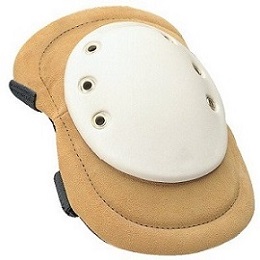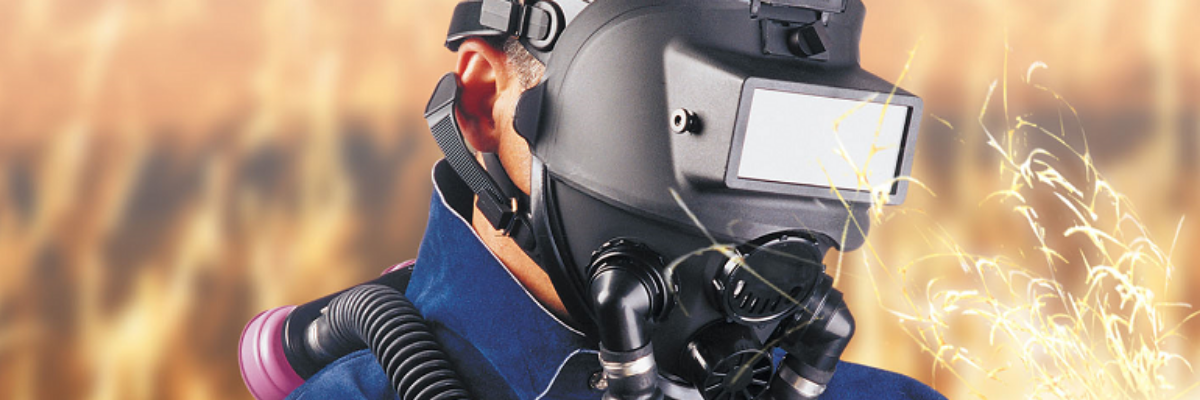
Welding Gear - Definitive Guide
Whether we’re going on a wedding or on a business trip, you’re all thinking what to wear. For many social gatherings, it means how good you want to look. But, if you're involved in risky jobs, the first consideration should and must be safety. For example, factory workers may be needed to wear safety boots and goggles. In construction, workers may be called to wear a hard hat. Therefore, welders should take extra attention to protecting themselves from potential hazards like air contamination, compressed gases, electric shock, arc radiation, cleaning processes, and fire or explosion. Welding injuries, from minor welding skin burns to 3rd-degree severe burns, can be painful and in extreme cases, cause many deformations and lead to career-ending disabilities. Wearing the PPE (proper personal protective equipment) is best way welders can protect themselves against these dangerous and save their livelihood. In order to avoid all these risky situations and to achieve the best welding results without stress, we make a list of 13 welding safety gear essentials for any starter welding kit, job, or project.Welding Helmets
Protecting your face and neck from sparks and radiation, a welding helmet is essential to weldings like a welding torch or machine. Helmets typically include the full face-covering element and a built-in lens. Long periods of exposing to arc radiation can seriously hurt your peepers. It’s essential to wear professional and effective eye protection while you’re performing a weld or are in the vicinity to a welding arc. Welding helmets are available in 2 different styles:- fixed shade
- and auto-darkening.
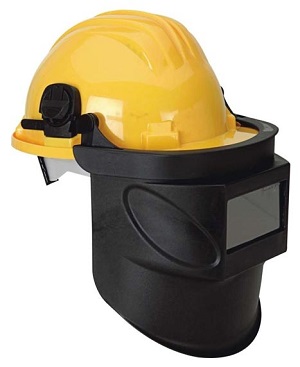
When you’re picking a fixed shade helmet, be sure choose the proper shade for the weldment you’re going to perform. It’s because they’ll only offer the same level of protection despite the light level emitted from the arc. There are various grades of fixed shade helmet which are best matched to different amperage. Most helmets are ranging from #9 to #13 grade. If you’re only working one type of welding on material with the same parameters, then fixed shade is a great choice, but if you're going to vary welding parameters, then an auto-darkening helmet is imperative. Technology has such impact on these helmets, they used to have optical sensors which detected light from the weld and changed accordingly, but now they have 2-4 magnetic sensors which detect a magnetic field generated by the arc. It signifies that auto-darkening helmets can modify the shade of the lens much faster and more reliably.
Lenses
They come in passive and automatic darkening variants. Passive lenses, which are made from polycarbonate, plastic or less commonly glass, are mostly available in 2- by 4.25" and 4.5- by 5.25ch" dimensions. Shades range from #3 lightest to #15 darkest and should match the current range and type of welding process. Clear inner and outer lenses guard and prolong the life-span of the shaded lens and provide additional impact protection. Outer lenses shield the tinted lens from welding spatter, extending the life. Inner lenses protect the welder if the tinted glass lens crack.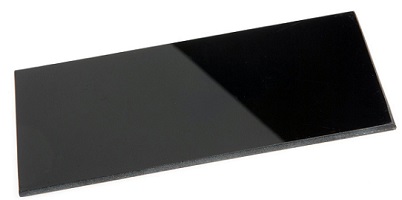
Auto-darkening lenses are electronic and provide the welder to see the work area clearly before the welding operation starts. When the application starts, the lens automatically darkens itself, guarding the welder’s eyesight. These lenses are available in single shades, even though they also come in adjustable shades, which is excellent for welders who practice various types of welding.
Safety Glasses
Glasses don’t provide the full-face protection that masks do. But they may be useful in some instances. They should be worn underneath the welding helmet to advance protection eyes, or without a mask, if you're cutting or only need to protect eyes from debris or dust. The crucial thing to take into account when choosing welding glasses is its shade number. They're available in a many different shades. The shade number is a measure of the lens darkness, and there are various shades recommended for multiple welding processes and the amperage utilized.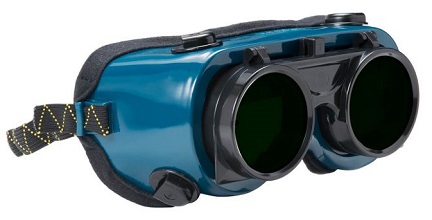
Specific welding methods produce a brighter arc than others, so these need a higher shade number. Other kinds of welding require a lower shade number so that it’s not too dark to see the weld pool. As a general guideline, GMAW/MIG and GTAW/TIG should be minimum 8-10, SMAW/Stick welding should be 8-12 depending on the amperage, and carbon arc welding should be minimum 14. Safety glasses should thoroughly cover your eyes at the side with either wraparound lenses or side shields and should be complied ANSI Z87 standards. You may also wear them instead of a welding helmet if you need to get into tight areas. Still, it doesn’t mean that you’ll protect the rest of your face. Tinted safety glasses or goggles can be worn instead of welding helmets only for light gas welding and cutting applications, but they should be utilized with face shields for impact protection. All arc welding and hotter forms of gas need a welding helmet or hood to protect versus facial burns and impact.
Respirators
They’re a crucial and often-overlooked piece of welding safety equipment. Underneath the welding helmet, the welder also should wear a welding respirator fabricated from flame-retardant material to protect against fumes and particulates. Heated metals can “send” toxic gasses into the air, especially zinc and magnesium fumes. These toxic fumes can cause Parkinson’s disease, asthma, lung cancer, and hearing loss. People often avoid the respirator since they can’t find the one that fits under welding mask. You need to put the extra work into looking for small, low-profile respirators that fit your mask and protect adequately. Inappropriate respirator use is another danger. Respirators won't work without the adequate filters or air supply. Ensure that the type of respirator you purchase matches with the kinds of materials you work with. And always check does the respirator fit and seal, or else it won't “preserve” you at all.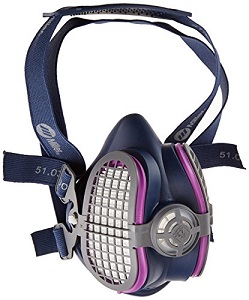
You can also check the respirator’s NIOSH (National Institute of Occupational Safety and Health) rating to ensure it meets the requirements.
Welding Gloves
Welding gloves have come on a long journey since the “one size fits all “time, and there are now several gloves available for different purposes. You can also find them in a range of different materials, like deerskin, pigskin, goatskin, and kevlar along with the option of wool lining for added comfort. TIG welding gloves combine durability and flexibility. To deliver extra handiness, they're unlined and made of smooth, heat-resistant leather, such as goat or deerskin. Most of the welders agree that TIG gloves should fit snug so they can manipulate electrodes without difficulty. Heavy-duty MIG and stick welding gloves are produced to protect welder from spatter and heat. Choose gloves with flame-resistant construction, heavy stitching, and multiple layers of insulation. Specific heavy-duty welding gloves have silicone patches for extra protection from spatter and heat.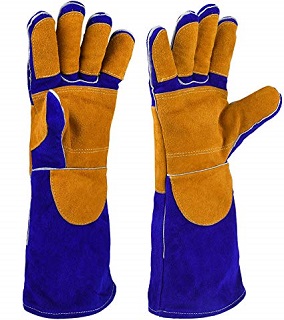
Standard-duty MIG welding gloves are typically made of leather and provide more dexterity and less insulation than heavy-duty gloves. Heavier MIG gloves are lined, and light to medium duty solutions are unlined. Search for Lincoln or Miller welding gloves if MIG welding is your primary task.
Welding Hats
Welding hats are 100% cotton and often made with exciting designs and colorful threads, but welding hats will protect head and ears during the welding project. While some welders preferer hats with the smooth edges they can place over either ear to protect from slag and sparks. On the other hand, some welders favor bandannas (large handkerchief worn tied around the head and neck) or beanies (a small, close-fitting hat worn on the back of the head) to keep sweat out of their eyes. Despite hat’s features, the best welding hat will provide both protection and comfort. Pick one that fits appropriately beneath the welding helmet and remember that heavier cotton provides extra comfort but can become hot over during the long work.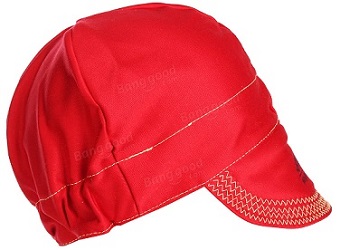
Welding Jackets
Suede or leather welding jacket will provide complete protection to arms and upper body and safely block all slag and sparks that may reach while working. They're a great piece of welding clothing for welders that perform in colder climates because in welding jacket welder remains warm and protected at the same time. For light-duty welding applications, cotton jackets are available in both specially designed flame-resistant cloth and treated flame-resistant cloth. While either can spare your skin from heat without bogging you down with unnecessary weight, engineered flame-resistant jackets are washable and more durable than classic cotton jackets. They provide superior durability and flame resistance in medium and heavy-duty applications. The drawback is, it gets hot underneath all that heavy pigskin. Still, leather offers the best mix of protection and durability. Jackets made with flame-resistant fabrics bring together the protection and durability of leather with the lightness of cotton. The advantage of a jacket is that protects areas that aprons don't. Jackets are great as welding neck protection since cover the entire neck area, shoulders, and back. A good welding jacket should be sturdy and fire-proof, regardless of the material.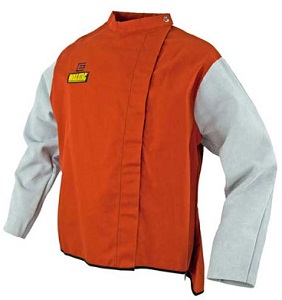
Welding Aprons
Aprons are ideal welding protective gear hot workshops or summer welding projects. Also, they provide a big amount of coverage and plenty of breathing space. Bibs have the same construction but don't extend as far down. The quality of a welding apron depends mostly on the material or fabric used in its manufacturing. Welding aprons should be structured from an extremely durable material like pigskin or cowskin leather. The use of aprons either made from traditional cowskins or pigskins offer a high stage of protection during any welding work. There are 2 basic types of aprons available. A half apron that provides lower waist protection and full apron that guards the welder’s entire front side. Certain aprons are made of cotton or heavy denim. These are available at very affordable prices compared to the leather ones. High-quality aprons have flame retardant cotton to better protect the welder from high heat or even open flames. All of these materials help to ensure that the apron won’t catch fire when sparks fly. Anyhow, it’s important to know that some aprons are only flame-retardant treated. So, they’ll lose flame resistance features after washing.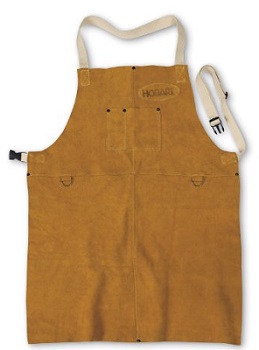
It’s crucial to pick a welding apron that provides the right combination of protection, strength, and comfort.
Don’t forget that high heat from welding can make colors bleed from certain aprons onto clothes. Bear this in mind when choosing and buying a new apron.
Welding Shirts
Long sleeve cotton shirt that buttons up high are perfect for welding work and provide coverage to upper body and arms. Synthetic materials will "hook" sparks and then melt onto your skin.Besides, short sleeves won't protect your arms from sparks or harmful UV rays. If you pick a short-sleeve cotton shirt, make sure you wear long welding sleeves.Wool is also a safe clothing material for welding work. Some shirts are specially engineered to be flame resistant, making them a much more reliable solution for welding tasks.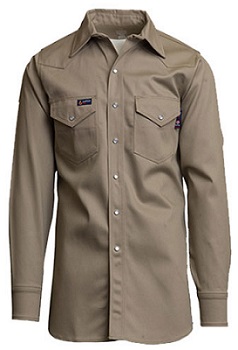
Welding Sleeves
They are the perfect welding clothes for small jobs and hot workshops. They serve a similar purpose to a welding jacket, but only cover the arms. Sleeves commonly go from the wrist to above the shoulder, where they clip onto apron or shirt. Also, have holes to accommodate gloves in order to achieve protection from fingers to arm. There are also sleeves with built-in gloves called welding gauntlets. They’re helpful for quick welding tasks that. It’s often easier to wear the apron, sleeves, and gloves than to “jump” in a full jacket for a one-and-done weld.Welding sleeves are ideal when paired with a welding apron for jobs that call for a higher degree of arms protection.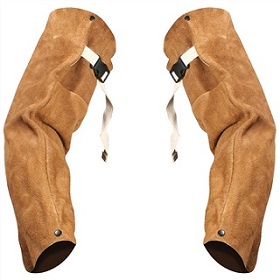
Welding Chaps
Welding chaps protected the legs and come in 2 forms: pants only, or overall-type with an attached bib. The overall-type chaps deliver the combined coverage of an apron and a pair of regular chaps. They’re a great welding protective clothing option for you the separate pants and apron may be too restrictive, bulky, or hot. Standard welding pants are better if you prefer an apron style and don’t need two bibs. Chaps come in whether a lighter, breathable cotton fabric or a sturdy leather, with synthetic models also. The other thing to consider is either you want partial or full leg covering. Since some welding chaps will only come a bit below the knee while others cover all the way to the ankle. It may be worth considering if you weld in an exceptionally warm or airless environment. Since some welding chaps will only come a bit below the knee while others cover all the way to the ankle. It may be worth considering if you weld in an exceptionally warm or airless environment.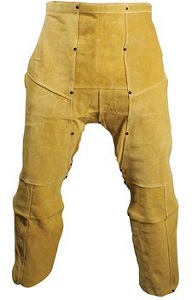
Kneepads
Being a welder means you may be kneeling for hours per day, usually in less-than-comfortable places. Kneepads will “save” your knees from other pain of sharp rocks or rough concrete. They can even provide more protection from random parts of scrap that may fall during a project. Kneepads are typically flexible strap-on welding apparel with solid protective and cushioning components. They should have a fine protective layer of leather or hard plastic. The inside should have an adequate cushioning layer without losing its flexibility. You can also find some welding chaps that include a built-in kneepad option.